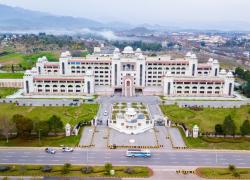Conceptualizing a theoretical framework for qualitative research: Exemplifying 03 relevant theories
Once I negotiated with the embarrassment, I experienced during the PhD research proposal presentation stage, discussed in my early blog- Writing a theoretical framework for a PhD thesis: How important it is?, I started afresh, the search of a theory to support my proposed research work and help conceptualize a theoretical framework for my PhD thesis.
It took me almost a year to conceive, comprehend, select and integrate the theoretical framework in my dissertation. Though it was a bit hectic nevertheless it was an enriching learning experience in its own right.
In my previous blog post- Understanding the difference between theoretical and conceptual frameworks, I have explained, in detail, what the terms theoretical and conceptual frameworks essentially means, its significance in research work, the challenges confronted by the doctoral candidates while writing a theoretical framework and the difference between theoretical and conceptual frameworks.
In this article, I want to share my personal experience and insight with the novice PhD students, research scholars and doctoral candidates who are struggling while envisaging their theoretical or conceptual frameworks. Some more examples of the theoretical and conceptual frameworks shall be discussed in the next blog post.
Conceptualizing a theoretical framework for my PhD research work/thesis
While investigating the existing gaps in the system of recruitment and selection in the public sector universities in Pakistan, critical review of the literature revealed dichotomy between intended and actual HR practices in the organizations in the developing countries. To get a deeper insight into this situation, I came across several management theories that were explaining the phenomenon and hence could potentially be used as a theoretical lens for my PhD research/thesis. The most compelling among those were the Contingency Theory, Structuration Theory and General Systems Theory.
In this blog post, I briefly discuss only those theories which were contemplated upon a lot more seriously before finally selecting a theory for my theoretical framework. This is intended to offer some valuable guidance for the PhD scholars to write their theoretical framework more effectively.
Contingency Theory
Being an organizational theory, the Contingency Theory postulates that there is no best way to run a business, manage an enterprise, lead a company, or make a decision. In lieu, the ideal course of action is contingent (dependent) upon the internal and external environmental forces. The Contingency Theory assumes that the appropriate organizational structure and management style are dependent upon a set of “contingency” factors, such as the uncertainty and instability of the environment.
Rather than proving a specific solution to solve organizational problems, the Contingency Theory provides a framework where every solution to a conundrum depends upon the environmental conditions. This essentially entails that the same problem can have multiple solutions at different points in time and different problems can have the same or similar solutions at the same point of time.
An integration of different schools of thought such as classical, behavioural and systems approaches, the Contingency Theory has proved immensely useful for practicing managers and professional for being adaptive in nature as it thinks of all possible factors, remedies and solutions that affect the situation and adopt the best alternative.
The critics assert that the Contingency Theory does not follow the concept of ‘Universality of Principles’ which often apply to a specific management situation. It is argued that that there is no definite solution to a problem and managers think of alternatives to arrive at the right choice. Moreover, it is argued that the Contingency Theory does not provide a theoretical foundation upon which management principles may be based upon. Moreover, it seems not possible for the managers to determine all the relevant factors for decision making. Due to numerous impending constraints such as time, money and capacity, managers can neither collect complete information about the environmental factors nor analyze the situation in totality.
Contingency Theory, while valuable in emphasizing that there is no one-size-fits-all approach to management, faces criticism for its lack of specificity and practical applicability. Critics argue that the theory is overly complex and does not provide clear guidelines for HR managers, as it suggests that the optimal course of action depends on numerous, often ambiguous situational factors. This complexity can make it challenging to implement effectively in real-world scenarios. Additionally, the theory has been criticized for its reactive nature, implying that managers should adapt to external conditions rather than proactively shaping their environments. Moreover, empirical support for Contingency Theory is sometimes inconsistent, raising questions about its reliability and generalizability across different organizational contexts.
Besides, it is also not possible to establish a perfect nexus amongst these factors. It is postulated that the application of the Contingency Theory may, therefore, be confounded at times since decisions are based on limited information. Hence, the underlined criticism was taken into consideration while offsetting it as a theoretical framework for my study. Moreover, the inherent complexity of the theory suggested against espousing it as a theoretical framework.
Structuration Theory
While looking into the construct of the Structuration Theory, it was found that Structuration Theory digs deeper into the relations between the structure that is the intended structure of the organization and the human behaviour which is the actual action of the top management as well as line management in an organization. Propounded by the British sociologist, Anthony Giddens, this social theory of the creation and reproduction of social systems is based on the analysis of both structure and agents working in the system.
The focus of the theory is the reciprocal relationship between human actors and organizational structure. Structural properties of a social system comprised of the rules and resources that human agents use in their everyday relations. This reciprocal interaction between agency and structure is cardinal to the fundamentals of Structuration Theory and is expressed as the ‘duality of structure’. The Structuration Theory came up with a framework that elucidates the relationship between structures, modalities and actions – structure consisting of all the three dimensions.
This social theory has widely been used by scholars, researchers and social scientists to provide a theoretical lens for their research studies in multiple disciplines with a focus on social setup. Since my doctoral research was intended to investigate into the factors that played a role in creating a gap between intended and actual HR practices with respect to recruitment & selection, Giddens’ Structuration Theory was assumed to be providing a theoretical lens, delineating the link of modalities with intended and actual HR practices.
However, limited literature was found about the influence of these modalities on the gap between intended and actual human resource management systems with particular reference to recruitment and selection, hence the theory was not pursued further. Besides, the underlying intricacies involved in the basic terminologies associated with the Structuration Theory was another factor that suggested against embracing it as a theoretical framework for my Thesis.
During the course of these attempts, I was introduced to an important theory- the General Systems Theory postulated by Ludwig von Bertalanffy as a means of explaining the complexity of interaction among systems and subsystems within and outside the organization.
General Systems Theory
General Systems Theory resented by Ludwig von Bertalanffy as a means of explaining the complexity of interaction among the various clusters, groups and subgroups. Under the umbrella of General Systems Theory, all of the compounding elements of an organization are looked upon as part of one larger system which itself (the organization) used to be a part of a larger global system. Each sub-system is reckoned as a distinct entity underlying how it fits into the entire organizational structure and the role it plays within the larger system.
General Systems Theory visualizes the organization as an open system where continuous interaction takes place between the organization and its external environment. The employees who work in the organization are drawn from the external market, and they add new knowledge, skills, abilities and competencies to the organization resources to enable it to respond to indigenous, national and global innovative market trends, growth and sustainability. General Systems Theory is having a critical and useful function in comprehending the changing dynamics of the organization and its environment through the recruitment and selection.
In fact, the important HRM function-recruitment and selection does not take place in isolation in any organization. It is influenced not only by the context and type of organization, its type, size, structure, leadership styles, strategic objectives but also by the events occurring outside the organization that affect the organization as a whole.
While theoretical framework examined the General Systems Theory with microscopic care, however, it needed to be examined more broadly first. Elucidating ‘system thinking’, ‘how it works’ and aligning systems thinking with HRM as a subsystem, ingrained in a larger organizational context were the central themes of my exercise. The discourse was concentrated on the application of Systems Theory to diverse disciplines followed by application of the theory to HR practices in the developing countries context, hence, opening up a critical discussion and furnishing justification for the selection of the theoretical framework.
Since the General Systems Theory provided a useful insight and a strong underpinning while investigating the existing gaps in the system of recruitment and selection in the institutes of higher education as well as analyzing further the influence of environmental forces on the staffing functions in the universities, therefore, the same theory was selected as a theoretical framework for my doctoral research study.
Conclusion
During the course of my PhD research work, I analyzed numerous organizational/management theories which could potentially be used as a theoretical framework for my doctoral research. The 03 worthwhile among those included Contingency Theory, Structuration Theory and General Systems Theory. However, the inherent intricacies involved in the constructs of the Contingency Theory and Structuration Theory and application of social theories to organization/managements dynamics restrained me from discerning these theories as a theoretical framework for my dissertation.
While evolved over the years, the General Systems Theory, its basic principles and core tenets can still be applied to the system of employees’ recruitment and selection in any organization. This theory served to build up the theoretical foundation for seminal research work in numerous disciplines. Moreover, the General Systems Theory has already been used by other researchers as a theoretical framework while investigating gaps/loophole in the system of recruitment and selection in the universities as a part of their PhD research work. This provided sufficient grounds for my selection of the General Systems Theory as a theoretical framework for my doctoral research. Hence, the theoretical lens for my PhD research was provided by the General Systems Theory.


















